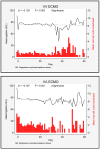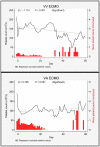Haematological Trends and Transfusion during Adult Extracorporeal Membrane Oxygenation: A Single Centre Study
- PMID: 37048711
- PMCID: PMC10095131
- DOI: 10.3390/jcm12072629
Haematological Trends and Transfusion during Adult Extracorporeal Membrane Oxygenation: A Single Centre Study
Abstract
The temporal trends in haematological parameters and their associations with blood product transfusion requirements in patients supported with extracorporeal membrane oxygenation (ECMO) are poorly understood. We performed a retrospective data analysis to better understand the behaviour of haematological and coagulation parameters and their associations with transfusion requirements during ECMO.
Methods: Patient demographics, haematological and coagulation parameters, plasma haemoglobin and fibrinogen concentrations, platelet count, the international normalised ratio (INR), the activated partial thromboplastin time (APTT), and blood product transfusion data from 138 patients who received ECMO in a single high-volume centre were analysed.
Results: Ninety-two patients received venoarterial (VA) ECMO and 46 patients received venovenous (VV) ECMO. The median (IQR) duration of VA, and VV ECMO was 8 (5-13) days and 13 (8-23) days, respectively. There were significant reductions in haemoglobin, the platelet count, and the fibrinogen concentration upon initiation of ECMO. On average, over time, patients on VV ECMO had platelet counts 44 × 109/L higher than those on VA ECMO (p ≤ 0.001). Fibrinogen and APTT did not vary significantly based on the mode of ECMO (p = 0.55 and p = 0.072, respectively). A platelet count < 50 × 109/L or a fibrinogen level < 1.8 g/L was associated with 50% chance of PRBC transfusion, regardless of the ECMO type, and packed red blood cell (PRBC) transfusion was more common with VA ECMO. APTT was predictive of the transfusion requirement, and the decrement in APTT was discriminatory between VVECMO survivors and nonsurvivors.
Conclusion: ECMO support is associated with reductions in haemoglobin, platelet count, and fibrinogen. Patients supported with VA ECMO are more likely to receive a PRBC transfusion compared to those on VV ECMO. Thrombocytopaenia, hypofibrinogenaemia, and anticoagulation effect the likelihood of requiring PRBC transfusion. Further research is needed to define optimal blood management during ECMO, including appropriate transfusion triggers and the anticoagulation intensity.
Keywords: anticoagulation; extracorporeal membrane oxygenation; packed red blood cells; restrictive transfusion.
Conflict of interest statement
The authors declare no conflict of interest.
Figures






Similar articles
-
Anticoagulation and Transfusions Management in Veno-Venous Extracorporeal Membrane Oxygenation for Acute Respiratory Distress Syndrome: Assessment of Factors Associated With Transfusion Requirements and Mortality.J Intensive Care Med. 2019 Aug;34(8):630-639. doi: 10.1177/0885066617706339. Epub 2017 May 1. J Intensive Care Med. 2019. PMID: 28460592
-
Transfusion practice in patients receiving VV ECMO (PROTECMO): a prospective, multicentre, observational study.Lancet Respir Med. 2023 Mar;11(3):245-255. doi: 10.1016/S2213-2600(22)00353-8. Epub 2022 Oct 11. Lancet Respir Med. 2023. PMID: 36240836
-
Prognostic impact of blood product transfusion in VA and VV ECMO.Perfusion. 2019 Apr;34(3):246-253. doi: 10.1177/0267659118814690. Epub 2018 Nov 16. Perfusion. 2019. PMID: 30444173
-
Blood Transfusion Threshold in Patients Receiving Extracorporeal Membrane Oxygenation Support for Cardiac and Respiratory Failure-A Systematic Review and Meta-Analysis.J Cardiothorac Vasc Anesth. 2021 Apr;35(4):1192-1202. doi: 10.1053/j.jvca.2020.08.068. Epub 2020 Sep 10. J Cardiothorac Vasc Anesth. 2021. PMID: 33046363
-
Heparin-induced thrombocytopenia during extracorporeal life support: incidence, management and outcomes.Ann Cardiothorac Surg. 2019 Jan;8(1):19-31. doi: 10.21037/acs.2018.12.02. Ann Cardiothorac Surg. 2019. PMID: 30854309 Free PMC article. Review.
Cited by
-
Improving ECMO therapy: Monitoring oxygenator functionality and identifying key indicators, factors, and considerations for changeout.J Extra Corpor Technol. 2024 Mar;56(1):20-29. doi: 10.1051/ject/2023047. Epub 2024 Mar 15. J Extra Corpor Technol. 2024. PMID: 38488715 Free PMC article. Review.
References
-
- Bartlett R.H., Gattinoni L. Current status of extracorporeal life support (ECMO) for cardiopulmonary failure. Minerva Anestesiol. 2010;76:534–540. - PubMed
-
- Peek G.J., Mugford M., Tiruvoipati R., Wilson A., Allen E., Thalanany M.M., Hibbert C.L., Truesdale A., Clemens F., Cooper N., et al. Efficacy and economic assessment of conventional ventilatory support versus extracorporeal membrane oxygenation for severe adult respiratory failure (CESAR): A multicentre randomised controlled trial. Lancet. 2009;374:1351–1363. doi: 10.1016/S0140-6736(09)61069-2. - DOI - PubMed
-
- Ang A.L., Teo D., Lim C.H., Leou K.K., Tien S.L., Koh M.B. Blood transfusion requirements and independent predictors of increased transfusion requirements among adult patients on extracorporeal membrane oxygenation—A single centre experience. Vox Sang. 2009;96:34–43. doi: 10.1111/j.1423-0410.2008.01110.x. - DOI - PubMed
-
- Hein E., Munthe-Fog L., Thiara A.S., Fiane A.E., Mollnes T.E., Garred P. Heparin-coated cardiopulmonary bypass circuits selectively deplete the pattern recognition molecule ficolin-2 of the lectin complement pathway in vivo. Clin. Exp. Immunol. 2015;179:294–299. doi: 10.1111/cei.12446. - DOI - PMC - PubMed
LinkOut - more resources
Full Text Sources

